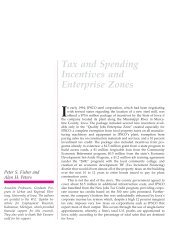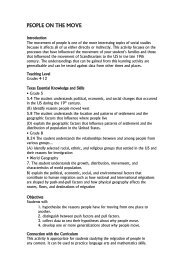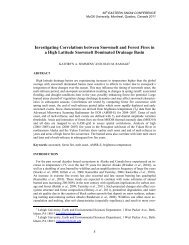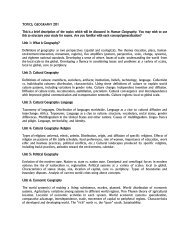Texas Social Studies Framework - Department of Geography ...
Texas Social Studies Framework - Department of Geography ...
Texas Social Studies Framework - Department of Geography ...
You also want an ePaper? Increase the reach of your titles
YUMPU automatically turns print PDFs into web optimized ePapers that Google loves.
3<br />
Making Connections<br />
through <strong>Social</strong> <strong>Studies</strong><br />
The wisdom <strong>of</strong> the adage “everything is connected to<br />
everything else” is appreciated only by those who have<br />
experienced the variety <strong>of</strong> relationships that exist<br />
between and among events or other phenomena. Long<br />
before the research <strong>of</strong> Jean Piaget was known, parents<br />
and teachers understood that children and adolescents<br />
needed concrete representations <strong>of</strong> relationships between<br />
phenomena in order to understand the connections. The<br />
writers <strong>of</strong> the TEKS for <strong>Social</strong> <strong>Studies</strong> also understood<br />
that social studies includes more than just the independent<br />
facts <strong>of</strong> history and geography. Because <strong>of</strong> their<br />
efforts, the TEKS provide opportunities to make connections<br />
across the social studies and across the curriculum.<br />
In addition, the TEKS support connections between inschool<br />
and out-<strong>of</strong>-school experiences.<br />
CONNECTIONS ACROSS THE SOCIAL<br />
STUDIES<br />
Members <strong>of</strong> the TEKS writing team organized the TEKS<br />
for <strong>Social</strong> <strong>Studies</strong> around eight strands because they<br />
represent some <strong>of</strong> the most significant sources <strong>of</strong> content<br />
for the K-12 social studies program (see Figure 2,<br />
Chapter 2). This organization allows a clear view <strong>of</strong> the<br />
vertical articulation or sequence <strong>of</strong> the social studies<br />
content and skills across the grade levels. Educators at<br />
the district, campus, and classroom levels have the<br />
opportunity to make decisions regarding the organization<br />
<strong>of</strong> the curriculum at each <strong>of</strong> the grade levels. This allows<br />
districts the freedom to develop curriculum units that<br />
combine and sequence the TEKS in a number <strong>of</strong> different<br />
ways.<br />
It is unlikely that all strands will be given equal weight in<br />
any particular instructional unit. In some instances only<br />
some strands will be chosen as the basis for instructional<br />
planning. The richness and diversity <strong>of</strong> social studies as a<br />
subject matter, however, come in part from the contributions<br />
<strong>of</strong> each strand to the instructional program.<br />
CONNECTIONS ACROSS THE CURRICULUM<br />
Content from other school subjects can be linked to<br />
social studies in order to help students make connections<br />
across the curriculum (Jacobs, 1989; Maurer, 1994). The<br />
TEKS for <strong>Social</strong> <strong>Studies</strong> require students to apply<br />
mathematics skills and English language arts and reading<br />
skills regularly. <strong>Social</strong> studies also influences these<br />
subjects. When students describe the impact <strong>of</strong> historical<br />
events and eras on art, music, and literature, and the<br />
reciprocal effects <strong>of</strong> cultural movements on societies, a<br />
deeper understanding <strong>of</strong> both social studies and the fine<br />
arts is fostered. Science informs social studies just as<br />
social studies informs science. The science, technology,<br />
and society strand <strong>of</strong>fers an obvious connection as<br />
students examine the cause-and-effect relationships<br />
between scientific discoveries, technological innovations,<br />
and societal change.<br />
Another kind <strong>of</strong> connection exists between the TEKS for<br />
<strong>Social</strong> <strong>Studies</strong> and the TEKS for Technology Applications.<br />
Students in elementary, middle, and high school<br />
social studies classes are expected to use technology as a<br />
tool to acquire, organize, and communicate social studies<br />
information in a variety <strong>of</strong> ways including electronic
















